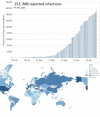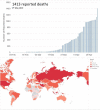Infection and mortality of healthcare workers worldwide from COVID-19: a systematic review
- PMID: 33277297
- PMCID: PMC7722361
- DOI: 10.1136/bmjgh-2020-003097
Infection and mortality of healthcare workers worldwide from COVID-19: a systematic review
Abstract
Objectives: To estimate COVID-19 infections and deaths in healthcare workers (HCWs) from a global perspective during the early phases of the pandemic.
Design: Systematic review.
Methods: Two parallel searches of academic bibliographic databases and grey literature were undertaken until 8 May 2020. Governments were also contacted for further information where possible. There were no restrictions on language, information sources used, publication status and types of sources of evidence. The AACODS checklist or the National Institutes of Health study quality assessment tools were used to appraise each source of evidence.
Outcome measures: Publication characteristics, country-specific data points, COVID-19-specific data, demographics of affected HCWs and public health measures employed.
Results: A total of 152 888 infections and 1413 deaths were reported. Infections were mainly in women (71.6%, n=14 058) and nurses (38.6%, n=10 706), but deaths were mainly in men (70.8%, n=550) and doctors (51.4%, n=525). Limited data suggested that general practitioners and mental health nurses were the highest risk specialities for deaths. There were 37.2 deaths reported per 100 infections for HCWs aged over 70 years. Europe had the highest absolute numbers of reported infections (119 628) and deaths (712), but the Eastern Mediterranean region had the highest number of reported deaths per 100 infections (5.7).
Conclusions: COVID-19 infections and deaths among HCWs follow that of the general population around the world. The reasons for gender and specialty differences require further exploration, as do the low rates reported in Africa and India. Although physicians working in certain specialities may be considered high risk due to exposure to oronasal secretions, the risk to other specialities must not be underestimated. Elderly HCWs may require assigning to less risky settings such as telemedicine or administrative positions. Our pragmatic approach provides general trends, and highlights the need for universal guidelines for testing and reporting of infections in HCWs.
Keywords: diseases; disorders; infections; injuries; public health; review.
© Author(s) (or their employer(s)) 2020. Re-use permitted under CC BY-NC. No commercial re-use. See rights and permissions. Published by BMJ.
Conflict of interest statement
Competing interests: None declared.
Figures






References
-
- World Health Organization WHO Director-General’s opening remarks at the media briefing on COVID-19. Available: https://www.who.int/dg/speeches/detail/who-director-general-s-opening-re... [Accessed 3 May 2020].
-
- World Health Organization Coronavirus disease, 2019. Available: https://www.who.int/emergencies/diseases/novel-coronavirus-2019 [Accessed 3 May 2020].
